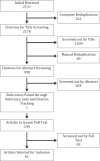Active surveillance for prostate cancer: a systematic review of clinicopathologic variables and biomarkers for risk stratification
- PMID: 25457014
- PMCID: PMC4483277
- DOI: 10.1016/j.eururo.2014.10.010
Active surveillance for prostate cancer: a systematic review of clinicopathologic variables and biomarkers for risk stratification
Abstract
Context: Active surveillance (AS) is an important strategy to reduce prostate cancer overtreatment. However, the optimal criteria for eligibility and predictors of progression while on AS are debated.
Objective: To review primary data on markers, genetic factors, and risk stratification for patient selection and predictors of progression during AS.
Evidence acquisition: Electronic searches were conducted in PubMed, Embase, and the Cochrane Central Register of Controlled Trials (CENTRAL) from inception to April 2014 for original articles on biomarkers and risk stratification for AS.
Evidence synthesis: Patient factors associated with AS outcomes in some studies include age, race, and family history. Multiple studies provide consistent evidence that a lower percentage of free prostate-specific antigen (PSA), a higher Prostate Health Index (PHI), a higher PSA density (PSAD), and greater biopsy core involvement at baseline predict a greater risk of progression. During follow-up, serial measurements of PHI and PSAD, as well as repeat biopsy results, predict later biopsy progression. While some studies have suggested a univariate relationship between urinary prostate cancer antigen 3 (PCA3) and transmembrane protease, serine 2-v-ets avian erythroblastosis virus E26 oncogene homolog gene fusion (TMPRSS2:ERG) with adverse biopsy features, these markers have not been consistently shown to independently predict AS outcomes. No conclusive data support the use of genetic tests in AS. Limitations of these studies include heterogeneous definitions of progression and limited follow-up.
Conclusions: There is a growing body of literature on patient characteristics, biopsy features, and biomarkers with potential utility in AS. More data are needed on practical applications such as combining these tests into multivariable clinical algorithms and long-term outcomes to further improve AS in the future.
Patient summary: Several PSA-based tests (free PSA, PHI, PSAD) and the extent of cancer on biopsy can help to stratify the risk of progression during active surveillance. Investigation of several other markers is under way.
Keywords: Active surveillance; Genetic markers; Nomogram; PSA; Prostate cancer; Risk stratification; Treatment.
Copyright © 2014 European Association of Urology. Published by Elsevier B.V. All rights reserved.
References
-
- Center MM, Jemal A, Lortet-Tieulent J, et al. International variation in prostate cancer incidence and mortality rates. Eur Urol. 2012;61(6):1079–92. Epub 2012/03/20. - PubMed
-
- Roobol MJ, Kerkhof M, Schroder FH, et al. Prostate cancer mortality reduction by prostate-specific antigen-based screening adjusted for nonattendance and contamination in the European Randomised Study of Screening for Prostate Cancer (ERSPC) Eur Urol. 2009;56(4):584–91. - PubMed
-
- Klotz L. Prostate cancer overdiagnosis and overtreatment. Current opinion in endocrinology, diabetes, and obesity. 2013;20(3):204–9. - PubMed
Publication types
MeSH terms
Substances
Grants and funding
LinkOut - more resources
Full Text Sources
Other Literature Sources
Medical
Research Materials
Miscellaneous


